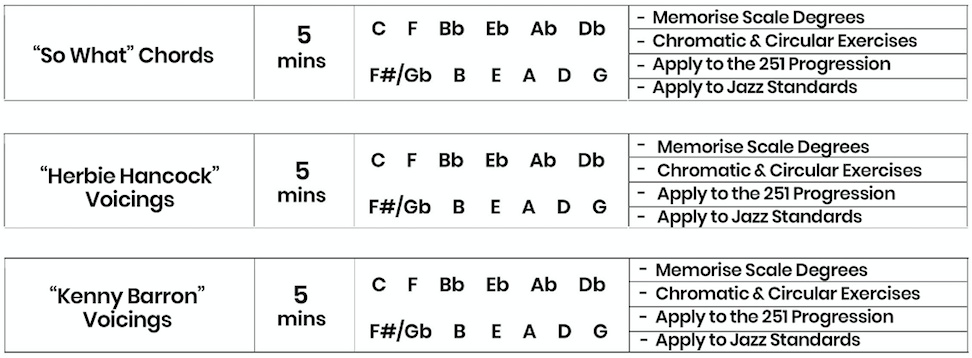Welcome to the Chord Extensions Practice Planner.
PianoGroove’s course on Extended Chords & Voicings introduces the concept of chord extensions and we explore the following topics:
- What are chord extensions?
- Where do chord extensions come from?
- What are some common/useful extended chord voicings?
- How can we apply extended chords to tunes we are working on?
Extended voicings give us the rich and lush-sounding chords that are one of the hallmarks of jazz piano. If you’re intrigued into how chord extensions work, then this course will answer all of your questions.
Download The PDF Practice Plan Here:
Chord_Extensions_Practice_Guide.pdf (1.9 MB)
This PDF download contains 6 core theory areas and associated drills for each topic. These 6 drills have been split over 4 digestible videos which are referenced below. These 4 videos will give a logical and methodical approach to learn and master extensions for major, minor, and dominant chords.
The plan has been created for a 1 hour practice slot. If you have longer available - 2 hours for example - simply double the time of each practice slot.
Let’s now run through the topics of this practice plan.
Slot 1: Major & Minor 9th Chords:
Slot 1 contains a selection of exercises and drills to get comfortable with major and minor 9th chords. The 9th is the first of the upper extensions 9, 11, & 13 and so it makes sense for us to isolate this ‘colour’ and work on it individually.
Here’s the video demonstration for slot 1:
Slot 2: Extending Past The 9th - Introducing 11ths & 13ths
In the second practice slot, we extend past the 9th of the chord to access the 11th and the 13th for major, minor, and dominant chords.
There are a few important points to understand: with 9ths, 11ths, & 13ths:
-
The 13th is the highest extension, if we extend past the 13th, we get back to the root.
-
The 9 is the same note as the 2 (but an octave higher), the 11 is the same note as the 4 (but an octave higher), and the 13 is the same note as the 6 (but an octave higher).
-
For Major and Dominant Chords, the 11 will typically be sharpened by a half step to the #11, this removes the dissonant half step interval between the major 3 and the natural 11.
Here is the video demonstration for slot 2:
Slot 3: The Major 251 Progression with 9ths & 13ths
In the Jazz Piano Foundations Course, we drilled through the 3-note voicings, for example, a 251 in C Major would be D-7 / G7 / Cmaj7
For practice drill 3, we will add the 9ths and 13ths to create a richer, and more harmonically interesting progression.
We follow the exact same principle that we did with our 3 note voicings, the b7 of the 2 chord drops by half a step to become the 3rd of the V chord. And what’s wonderful is the 9 doesn’t need to move and that same note becomes the 13th of G7.
Here is the video demonstration for slot 3:
Slots 4, 5, & 6 - How To Learn & Memorise Chord Voicings
The final 3 practice slots of this plan are all covered in 1 demonstration video.
The following lessons explore 3 useful minor 11th voicings.
- The So What Voicing
- The Herbie Hancock Voicing
- The Kenny Barron Voicing
Whilst practice advice and guidance is given in each of the above lessons, the video demonstration below is an updated and consolidated tutorial which breaks down everything you need to know when learning new chord voicings:
A 5-Step Process For Learning Chord Voicings:
-
The first thing to do is understand and memorise the construction in terms of scale degrees. This is the ‘formula’ or ‘blueprint’ for the chord. Pay particular attention to the top note of the voicing.
-
Next, take the voicings through all 12 keys. This is important! You can do this chromatically, and also around the circle of fifths. Once you have done this, you will never forget the voicing.
-
Then pick keys at random to test yourself.
-
Apply your new voicing in the context of the 251 progression. This will help you apply the voicing in the context of an actual progression so that you are ready to use it in the tunes you are playing.
-
Finally, flick through your fake book and look for opportunities to apply your new voicing. Look for the chord quality with the same scale degree in the melody as the top of the voicing. And bingo.
Always remember that when you work something out yourself, you will retain that information much better than from me showing you exactly what to play.





 well done
well done  That all makes sense! I’ll take your advice and trying alternating between 2 days of chord extensions/voicings and 1 day of foundation for a few weeks. I’ll check back in with a post here to let you know how it goes!
That all makes sense! I’ll take your advice and trying alternating between 2 days of chord extensions/voicings and 1 day of foundation for a few weeks. I’ll check back in with a post here to let you know how it goes!